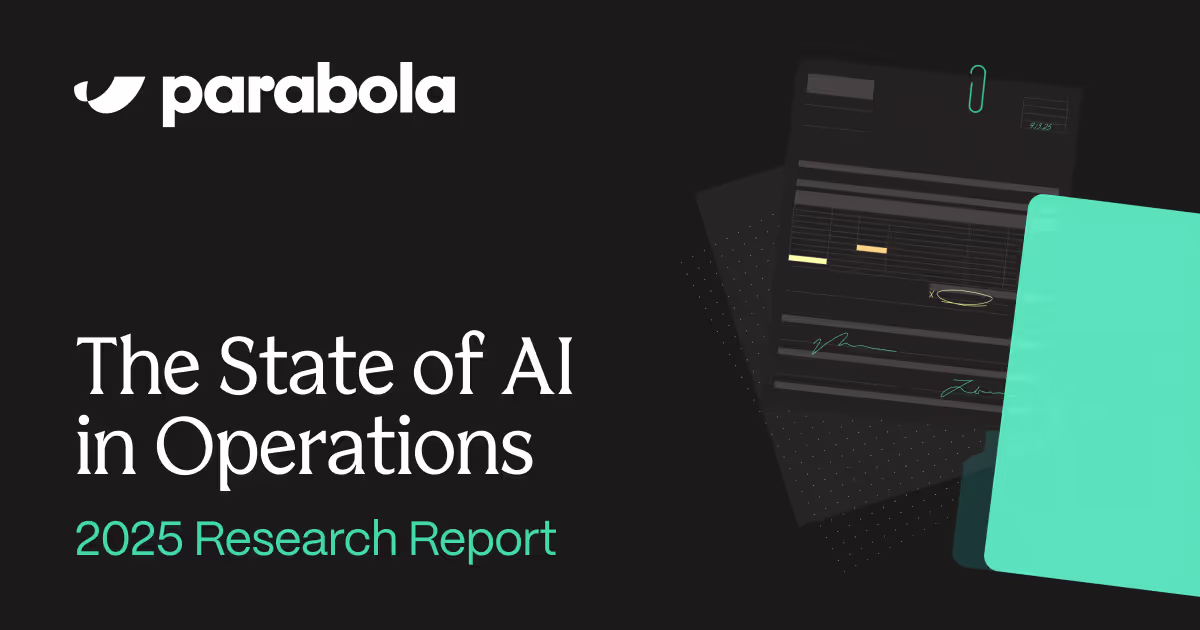Introducing The State of AI in Operations: 2025 Research Report

When we talk to operations teams, we keep hearing the same thing: "We're using AI." But when we dug deeper into what that actually meant, we found something surprising. While 98% of operations teams are using or experimenting with AI today, most are still in the experimental phase. Only 10% have AI in most workflows or as core to how they operate.
So we decided to find out why. We surveyed hundreds of operations professionals to understand where AI adoption really stands, what's holding teams back, and where teams see the clearest opportunities for value.
The results reveal a clear picture: AI in operations isn't a question of "if" anymore, but "how fast."
Download the full State of AI in Operations: 2025 Research Report →
Who we surveyed and how we conducted this research
We surveyed hundreds of operations leaders across industries and company sizes in Q3 2025. Nearly 89% of respondents are directly involved in evaluating or implementing new software and AI tools for their teams, giving us insights from the people actually making these decisions.

Key findings
1. 98% of operations teams are using AI, but only 10% have scaled beyond experimentation
98% of operations teams are using or experimenting with AI. Only 1.7% said they're not using it at all. But here's the reality of current adoption:
- 52% are using AI in some workflows
- 36% are experimenting with small projects
- Only 10% have AI in most workflows or as core to operations
When we asked teams to self-assess their AI maturity, 45% consider themselves intermediate (using AI for a few repeatable workflows), while only 21% have reached the advanced stage where AI creates real competitive advantage.
The takeaway: We're past the early adopter phase. The majority of operations teams have moved from "should we try AI?" to "how do we do this better?"
2. Trust and training are bigger barriers to AI adoption than budget
Here's what surprised us most: only 9% of operations teams cite cost as their biggest barrier to AI adoption.
The real blockers are:
- 41% cite trust and accuracy concerns
- 36% cite lack of expertise or training
- Only 9% cite cost/budget limitations
Trust and training concerns outweigh cost by nearly 5 to 1.
Meanwhile, 71% plan to increase their AI budgets in the next 12 months, with 21% planning significant increases.
The takeaway: Teams want to use AI. They have budget for AI. They can see the potential value. But they need to trust it will work correctly and they need to know how to use it effectively. This creates a clear opportunity for solutions that prioritize reliability, transparency, and user education.
3. Data entry and cleaning delivers the highest ROI from AI in operations
When we asked what would deliver the highest ROI from AI, the answer was overwhelmingly clear:
- 41% said data entry and cleaning
- 17% said reporting
- 16% said forecasting
- 13% said reconciliation
Data-centric work represents 87% of priority use cases.
The takeaway: Operations teams are focused on solving their most time-consuming, manual tasks first. Data entry and cleaning isn't glamorous, but it's where teams spend countless hours that could be better used elsewhere. Starting with data work also builds confidence, since the results are easy to measure and verify.
4. 68% expect AI to become industry standard in operations within 1-3 years
68% of operations leaders expect AI to be standard in their industry within the next 3 years. But here's the urgent part: 37% expect it to be standard in the next 12 months.
Only 14% believe it's already standard, which means there's a narrow window for competitive advantage.
The takeaway: This isn't speculation about the distant future—it's active planning for the immediate roadmap. Teams that don't have a clear AI strategy risk being left behind, not in years, but in months.
What this means for operations leaders
Operations teams are moving beyond the experimental phase and into practical implementation. They have clear priorities (data work), realistic timelines (1-3 years to become standard), and growing budgets (71% increasing spend).
But they're stuck at a critical juncture—between experimentation and scale. They've proven AI works in small projects, but struggle to move those wins into production workflows they can trust when it matters most.
AI adoption in operations isn't a future trend—it's happening right now. With most teams expecting AI to become standard within 12-24 months, timing is critical for building competitive advantages.
Key takeaways:
- Start with data entry and cleaning for quick wins that build confidence and free up time
- Invest in training and change management, not just technology since the barrier is confidence, not budget
- Choose solutions that prioritize accuracy and transparency to address the trust concerns holding teams back
- Act quickly—the timeline is months, not years with 37% expecting AI to be standard within 12 months
The window for competitive advantage is closing fast. While 98% of teams have started the journey, only 21% have reached the destination where AI creates real competitive advantage.
Download the complete State of AI in Operations: 2025 Research Report →
—
About the research: This report is based on survey responses from hundreds of operations professionals across industries and company sizes, conducted in Q3 2025.


